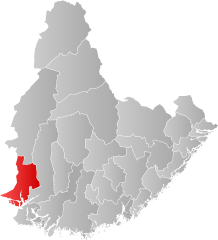Flekkefjord
| coat of arms | map | |
|---|---|---|

|
|
|
| Basic data | ||
| Commune number : | 4207 | |
| Province (county) : | Agder | |
| Administrative headquarters: | Flekkefjord | |
| Coordinates : | 58 ° 19 ′ N , 6 ° 40 ′ E | |
| Surface: | 544.07 km² | |
| Residents: | 9,028 (Feb 27, 2020) | |
| Population density : | 17 inhabitants per km² | |
| Language form : | Bokmål | |
| Postal code : | 4400 | |
| Structure: | Flekkefjord, Sira, Gyland, Rasvåg, Kirkehavn, Nes, Hidra, Gyland and Bakke | |
| Website: | ||
| traffic | ||
| Railway connection: | Flekkefjordbanen | |
| politics | ||
| Mayor : | Torbjørn Klungland ( FrP ) (2019) | |
| Location in the province of Agder | ||

|
||
Flekkefjord is the westernmost town and municipality on the southwest coast of Norway . It is in the Fylke Agder . The municipality borders on the municipalities of Sokndal and Lund in Rogaland -Fylke in the west and on Sirdal in the north and Kvinesdal in the east.
coat of arms
The coat of arms represents a pilot ship on a turbulent sea and can be traced back to 1855. The current version was created in 1899. The black spots in the sail indicated that it was a pilot ship.
The coat of arms was originally proposed by a Lieutenant Kaltenborn .
history
The first settlers are likely to have lived here as early as the Viking Age . But closed development did not come about until the timber trade privilege of 1660. The good connections to Holland also led to larger emigration movements to Holland. The great flowering came with the rich herring deposits between 1826 and 1838. On August 8, 1842, Flekkefjord received town and market rights . Then the leather industry (tannery) became the main industry for 100 years. After 1900, the range expanded to include woolen goods, timber and barrel factories, then also to the shipping industry and mechanical workshops. Some of the emigrants also returned and brought with them the Dutch way of life, names and furniture that are still widespread in the southwest today. The girls who had been in the Dutch service brought with them the Dutch ideas of hygiene and cleanliness, which at the time were far from common in their home country.
Until 1965, Flekkefjord was not much larger than the current town center. But with the local reform introduced at that time, Flekkefjord was merged with the surrounding municipalities of Nes , Hidra , Bakke and Gyland , which in turn brought in further districts.
The newspaper Agder Flekkefjords Tidende has been published in Flekkefjord since 1877 .
Since 1970 there has been a town partnership with Misburg , now part of Hanover .
traffic
A railway line, the so-called Flekkefjordbane , used to lead to Flekkefjord , which branched off from the main Oslo - Kristiansand - Stavanger line in Sira . This route had a restricted clearance profile due to a small tunnel cross-section . Since the old vehicles on the route were taken out of service and the Norges Statsbaner did not want to buy new trains due to the low traffic, operations on the route were stopped. The route can be traveled with a railroad trolley .
media
- Agder Flekkefjords Tidende (newspaper)
particularities
One of the sights is the so-called "Dutch town". It is a district in the north of Flekkefjord with narrow streets and some well-preserved white wooden houses. The connection to the Netherlands through the export of wood and fish goes back to the 13th century. Granite, bark and lobster were also traded. At that time the Netherlands had a great need for wood and stone, and an old description says that Amsterdam likes Norway. The trading center was in the “Dutch town”, which at that time consisted of only a few houses. Here were the inns and hostels. The Dutch stayed here when they came to town to do business.
sons and daughters of the town
- Søren Abildgaard (1718–1791), biologist, author and illustrator
- Marie Helene Aarestrup (1826–1919), genre, portrait and animal painter
- Peter Waage (1833–1900), chemist
- Christian Meyer Ross (1843–1904), painter
- Anders Beer Wilse (1865–1949), photographer
- Ingunn Foss (* 1960), politician
- Håvard Tvedten (* 1978), handball player
- Goal Henning Hamre (* 1979), soccer player
- Gisle Meininger Saudland (* 1986), politician


